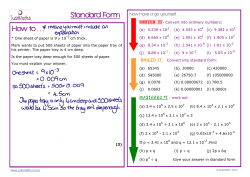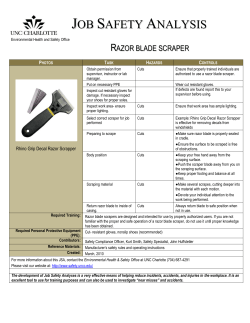
Schick Champions Its Tracer Razor
ast year's Super Bowl broadcast introduced the world to Gillette's Sensor shaving system. Not long after this year's football extravaganza, Schick® announced its own challenger: the Tracer razor system. After 14 years of research and development and a $50-million capital investment, Schick believes Tracer's "interactive" package will help make it a champion in the retail razor and blade market-which the company estimates is worth $770 million. How? With a pushbutton device that lets the buyer "test-drive" Tracer's flexible razor cartridge. The button is one of four packaging components thermoformed by Crystal Thermoplastics. Two of those components hold the razor, providing permanent storage convenience for the consumer. But it's the thermoforming process itself that shaves considerable tooling and material costs for CT and Schick. Billed by Schick as the "first razor with a cartridge that flexes to follow L the contours of your face," Tracer's thermoformed components sleekly fit i nto a graphically striking, aerodynamic paperboard card. "It's such an amazingly simple concept, yet it's highly effective," says Warner-Lambert's Consumer Health Products Group president Ray LeFebvre. (Schick is part of the Morris Plains, N.J.-based W - L division.) He says Tracer is the single largest new product i ntroduction in Schick history and will be backed by a $30-million marketing effort aimed at gaining a 2.1-percent share of the market by year's end and 5 percent by 1995. In dollar terms, LeFebvre sees Tracer boosting Schick to great heights. " We're hoping that by 1995, Schick's dollar share of the market will grow from today's 16.4 level to 18.5." Schick reports the product has already been granted four U.S: patents with several patents pending worldwide. What makes the package compelling is that it does more than protect the razor and provide a catchy point-of-purchase attraction-it lets the consumer actually experience the razor cartridge's flexibility by pressing the pushbutton. "Tracer packaging is equally as innovative as the product," states LeFebvre. "It has high impact graphics and i ncorporates a unique pushbutton feature designed to let consumers test-drive the product. This way consumers can see for themselves exactly how Tracer works before. purchasing." Sometimes old ways are best The sleek modern look of product and package is aimed at, in Schick's rather florid phrase, "young, active. risk-taking achievers." When it came to manufacturing the package, however, "old reliables" were called upon. Thermoforming rather than i njection molding was chosen for its economy and relatively short l eadtimes. And carved epoxy mold models beat out some higher-tech alternatives during the R & D process. That's how the outer dome was developed. "This package has a flowing, organic shape, and we both felt we were better off with the old-fashioned method of working with epoxy models than with CAD/CAM, which is better suited for geometric shapes," says Michael Brown, CT's vice president of sales and marketing. "We began in early 1990 by carving some epoxy models from hand drawings. Then we went to some one-up prototype molds because Schick needed a couple hundred samples." Hand-crafted epoxy models made via trial-and-error might seem tedious and costly, but not to CT and Schick. "The epoxy models can be made up in a hurry," Brown explains. "When we were in the designing stage with Schick, we could make a model, they could modify it, we could go out to lunch, come back and another sample would be ready for them. Schick l oved that, I don't think it would have been feasible with i njection-molding equipment." However, Tracer lent itself to thermoforming for several reasons. First was the package configuration, suited to thermoforming. Then came the timing of its market introduction. Schick wanted the product available at the retail level by Jan. 1, 1991. "Thermoforming allowed us shorter leadtimes," explains Brown. "it took us six to eight weeks to build the final thermoforming tooling, whereas normally with injection molding, the turnaround is 12 to 16 weeks." By cutting tooling leadtimes in half, CT helped Schick meet its deadline. Tooling and material costs for thermoforming provided economic advantages as well. "There were certainly major cost savings in thermoforming," Brown says. Though he won't reveal specific material costs, he does say: "With thermoforming you're able to pull thin-wall sections. That reduces the amount of material that's needed." As far as tooling costs, Brown notes: "A thermoform mold only has to contact one surface of the plastic as the sheet is pulled down over the mold. The lightweight aluminum thermoforming tooling can be up to 10 times less expensive than standard injection-molding tooling." The finished components, both CT and Schick agree, maintain the look and feel commonly associated with i njection-molded pieces. Getting together CT and Schick worked closely on the entire Tracer package, from concept to final product. "The primary challenge for us was to make sure all the pieces interlocked properly while the package retained the look and style Schick wanted," Brown states. And what a challenge it was. According to W -L senior project engineer Don Thorpe, there were literally millions of possible tolerance combinations when all the components were considered. "In order for these four components to successfully unite, crucial dimensions of the cavities had to be held within plus or minus .015 i nches," adds CT general manager Rob Brown. The four thermoformed components include: • The critical pushbutton, made from 25-mil extruded polystyrene sheet, supplied in rolls by New Hampshire Plastics. The 1 1/4-in.-L button moves vertically between a keyway slotted into the razor tray base and the J.W Little-supplied paperboard card. The consumer pushes the button from the outside of the package via a die-cut slot in the card. As the V -shaped upper surface of the button is depressed, its bottom portion gently makes contact with the razor cartridge-providing the package's unique test ability. The keyway stops the button's vertical movement when the button makes contact, preventing razor head damage. • A razor base tray from 25-mil extruded PS sheet, also supplied in roll form by NHP. The razor snaps i nto the top side of this tray. The tray's headrest has raised platforms that protect the blade. It also lets water drain off the package without damaging the blades. An insert tray from 20-mil extruded PS sheet, again supplied in rolls by NHP. This tray snaps into the underside of the razor base tray. Fitting into the insert tray is another smaller tray, injection-molded by Schick Schick from polystyrene. The smaller, clear tray holds the two flexible razor cartridges. Once the consumer has used the package's original two cartridges, replacement packs (sold separately) are snapped i nto the insert tray. That capability provides the consumer with the permanent shaving system. Schick wanted all three of these PS components to have a steely metallic look, which was a challenge to NHP. The original prototypes were sprayed with silver paint. With the thermoformed tray, NHP had to develop the perfect balance between gray pigmented styrene and actual metal flake. If it didn't use enough flake, the sheet looked a dull gray-not metallic. Too much flake resulted in a streaked appearance. NHP, CT and Schick worked continually to modify the process until a satisfactory blend was developed. NHP declines to comment further on the blending of metal flake into the resin. In addition to NHP, CT reports that Primex is also supplying PS material. • The fourth thermoformed Tracer component is a clear 20-mil polyvinyl chloride dome cover that fits into the hinged card and protects the permanent components. Nan Ya supplies CT with the PVC in roll form. A sturdy convex rise at the dome's top affords the razor additional protection. W-12s manager of product and package design, David Byrne, says: "The shape of the dome conveys the Euro-style that's popular with our customers. It has the look of the nineties." The base of the dome is reverse-angle cut, allowing free-standing display on the retail shelf. CT thermoforms the dome cover, base tray and two-piece insert tray on either of two machines-Lyle's 128 or Sencorp's PI 2500. The pushbutton is thermoformed on a Sencorp 1600. The thermoforming process, Brown explains in a nutshell, is similar with all the components. "We put the mold into the press and then index the plastic that's heated to 300 degrees into the mold station. The press closes and is l ocked into place via top and bottom toggles. Pressure and vacuum then form the piece. A 60-degree water-cooling system runs underneath the molds and cools the pieces down. After the cycle, the pieces exit the machine and are trimmed off-line on a Schwabe DG hydraulic platen press." CT ships individual components to Mack Molding for contract packaging. Most procedures are completed manually. First, the razor is friction-fitted into the base tray. The insert tray is snapped into place underneath the base tray. A coupon may be placed within the insert tray j ust prior to the addition of the i njection-molded razor cartridge tray. Those components are placed within the clear dome cover in a slot die-cut from the paperboard card. The John W. Little Co. supplies the hinged .018 SBS card. It measures 15 15/16 i n. H x 4 in at its widest point when open. The card is offset-printed in four colors for the outside; two inside. A large gray arrow with orange trim shows the consumer where to push the button. A proprietary varnish is then applied. Little applies a special adhesive coating on the inner edges of the card. The card is precision die-cut in five places: three holes at the top to allow pegboard display; a fourth for the important keyway, which if too small won't allow the bottom portion of the button to reach the razor cartridge; and of course, a fifth cut to accommodate the thermoformed components and razor. Mack Molding places components into the hinged card, the card is folded and Reprinted from PACKAGING DIGEST March 1991 Copyright 1991 Delta Communications Inc. then the package is heat-sealed on a modified sealing machine supplied by a company no longer in business. The machine activates the sealant on the inside portion of the card. Afterwards, a pressure-sensitive polyester label supplied by CCL is applied automatically to the outer dome cover. The label measures 1 9/16 i n. L x 2 5/s in. W. It is flexo-printed i n yellow with the word "New" reversed out of an angled promotional flag, and a message, "Flexes to Follow the Contours of Your Face," positioned near the bottom of the label. CCL chooses not to reveal any further details about the label or the equipment used by Mack for competitive reasons. Once labeled, the package i s complete. Mack Molding sends product back to Schick for retail distribution. Looking sharp Tracer sells in supermarkets, drug stores and mass merchandise outlets at $3.39 to $3.69. Replacement cartridges cost between $3.79 and $3.89 for the five-pack; $6.99 to $7.29 for the 10-pack. Though the new shaving system has only been available for a short ti me, it has already proven successful during extensive consumer testing conducted in several cities. More than 3,000 men tried the razor a total of 30,000 times, with 75 percent saying they would purchase it. " We're extremely pleased with the test results," says Gary Paladin, Schick's senior product manager. "It's given us a vote of confidence that helped make the decision to proceed very easy. And the early trade response is overwhelmingly positive. I think we have a winner." More information on the thermoformer is available from: Crystal Thermoplastics, Inc., Box 7007, Cumberland Industrial Park, Cumberland, RI 02864, 401/333-6363, FAX 401/333-6592.
© Copyright 2025









